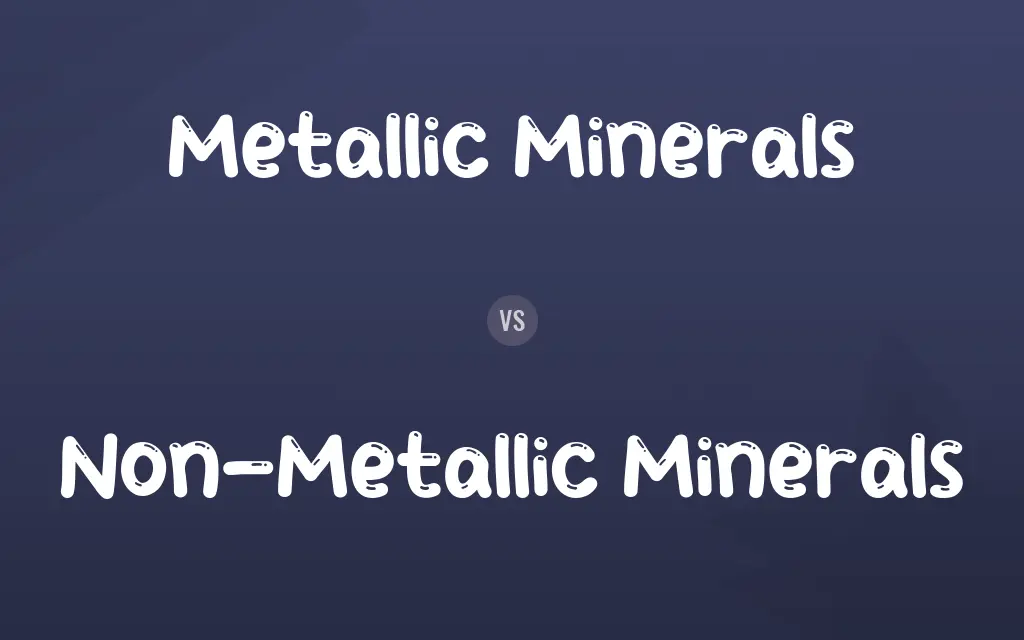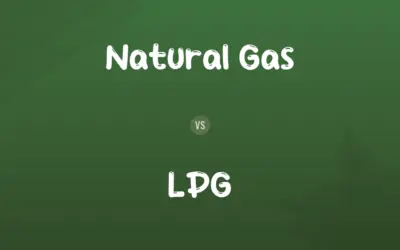Metallic Minerals vs. Non-Metallic Minerals: Difference and Comparison
By Muazma Batool & Muneeza Rehman — Published on May 23, 2024
Metallic minerals are typically malleable and conductive, often used in metal production, whereas non-metallic minerals, lacking metal content, serve in industries like ceramics and construction.

Difference Between Metallic Minerals and Non-Metallic Minerals
Metallic minerals, such as iron ore and copper, are crucial for their ability to conduct electricity and heat, essential in various industrial applications. On the other hand, non-metallic minerals like quartz and calcite are valued for their non-conductive properties, making them suitable for insulating materials and diverse industrial uses.
Muazma Batool
May 23, 2024
Metallic minerals are generally mined for their potential to be refined into pure metals or alloys, which are foundational in manufacturing and construction sectors. Conversely, non-metallic minerals are often utilized in their natural state or after minimal processing, such as in building materials, fertilizers, and cosmetics.
Muazma Batool
May 23, 2024
In terms of economic value, metallic minerals frequently command higher market prices due to their role in producing metals, which are integral to global economic infrastructure. In contrast, non-metallic minerals, while essential, typically have lower economic values but are crucial for their widespread industrial applications.
Muazma Batool
May 23, 2024
The extraction and processing of metallic minerals are often more energy-intensive and environmentally impactful, given the need to reduce ores to their metal forms. Non-metallic minerals, while also having environmental impacts, generally require less intensive processing methods.
Muazma Batool
May 23, 2024
Geologically, metallic minerals are usually found in igneous and metamorphic rocks, with distinct crystal forms and high density. Non-metallic minerals, however, are more commonly associated with sedimentary rocks and are characterized by a broader variety of physical properties and lower densities.
Muazma Batool
May 23, 2024
Metallic Minerals vs. Non-Metallic Minerals Comparison Chart
Processing
Energy-intensive refining
Less energy-intensive, minimal processing
Muazma Batool
May 23, 2024
Geological Occurrence
Found in igneous and metamorphic rocks
Common in sedimentary rocks
Levi
May 23, 2024
Metallic Minerals vs. Non-Metallic Minerals Definitions
◉Metallic Minerals
Found predominantly in specific rock types.
Bauxite, the primary ore of aluminum, forms in lateritic environments.
Nolan
Apr 29, 2024
◉Non-Metallic Minerals
Non-metallic minerals do not contain metal elements and are insulators.
Quartz is used in making glass due to its non-metallic nature.
Muazma Batool
Apr 29, 2024
◉Metallic Minerals
These minerals are typically ductile and have a shiny appearance.
Silver is processed from metallic minerals and used in jewelry making.
Muazma Batool
Apr 29, 2024
◉Non-Metallic Minerals
These minerals are often used in their raw form in various industries.
Limestone, a non-metallic mineral, is a primary ingredient in cement.
Muazma Batool
Apr 29, 2024
◉Metallic Minerals
Often associated with magnetic properties.
Magnetite, a type of metallic mineral, is naturally magnetic.
Muazma Batool
Apr 29, 2024
◉Non-Metallic Minerals
Can be found in various geological settings.
Potash is mined from evaporite deposits and used as fertilizer.
Muazma Batool
Apr 29, 2024
◉Metallic Minerals
Metallic minerals contain metal elements and exhibit high conductivity.
Copper ore is mined for its metallic properties useful in electrical wiring.
Muazma Batool
Apr 29, 2024
◉Non-Metallic Minerals
Typically have a broader color range and lower density.
Calcite, used in antacids, can appear in many colors depending on impurities.
William
Apr 29, 2024
◉Metallic Minerals
Extracted mainly for metal production.
Iron ore, a metallic mineral, is fundamental in steel manufacturing.
Muazma Batool
Apr 29, 2024
◉Non-Metallic Minerals
Valued for their chemical properties and uses outside of metal production.
Gypsum is employed in construction for making drywall.
Muazma Batool
Apr 29, 2024
Metallic Minerals vs. Non-Metallic Minerals Frequently Asked Questions
Do metallic minerals only come from specific types of rocks?
While more common in igneous and metamorphic rocks due to geological processes, metallic minerals can also be found in other rock types under certain conditions.
Lucas
May 23, 2024
Why are non-metallic minerals important in industries like cosmetics?
Non-metallic minerals such as talc are used in cosmetics for their softness, absorbency, and non-reactive nature.
Muazma Batool
May 23, 2024
What defines a mineral as metallic?
A mineral is classified as metallic if it contains metal elements and has metallic properties like conductivity and malleability.
Muazma Batool
May 23, 2024
What is the most common metallic mineral?
Iron ore is one of the most common and economically significant metallic minerals, primarily used in steel production.
Muazma Batool
May 23, 2024
What environmental impacts are associated with mining non-metallic minerals?
Mining non-metallic minerals can lead to environmental impacts such as habitat destruction, water pollution, and air pollution, though typically less severe than those caused by metallic mineral extraction.
Kaitlyn
May 23, 2024
Can non-metallic minerals be recycled?
Some non-metallic minerals can be recycled, such as glass made from silica sand, but many are used in forms that do not easily allow for recycling.
Muazma Batool
May 23, 2024
Can metallic minerals be non-conductive?
Generally, metallic minerals are conductive due to the presence of metals, which are excellent conductors of electricity.
Muazma Batool
May 23, 2024
Are all non-metallic minerals used in construction?
Not all, but many non-metallic minerals like limestone and sand are fundamental in construction due to their physical properties.
Muazma Batool
May 23, 2024
How are metallic minerals extracted?
Metallic minerals are typically extracted through mining operations, which involve digging, drilling, and blasting to access metal-bearing ores.
Lucas
May 23, 2024
What role do non-metallic minerals play in agriculture?
Non-metallic minerals like phosphate and potash are crucial in agriculture as components of fertilizers that enhance soil fertility.
Lucas
May 23, 2024
Content Creators
Written by
Muazma BatoolAs a content editor, Muazma Batool is not just a grammar guru but a creative mastermind who breathes life into every word. With an eagle eye for detail and a passion for storytelling, she transforms bland text into engaging content that captivates audiences and drives results.
Co-written by
Muneeza RehmanAt Comparisons.wiki, Muneeza skillfully navigates the vast sea of information, ensuring clarity and accuracy as the lead content editor. With a keen eye for detail, she curates every comparison to enlighten and engage readers.






























